The Everly Brothers Comeback Album EB '84
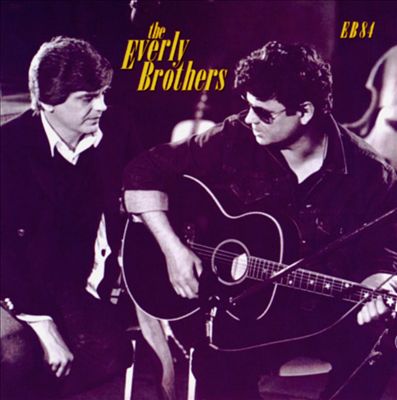 One of the Greatest Albums You May Not Have Heard Yet
One of the Greatest Albums You May Not Have Heard Yet
It had been one of the biggest and most public break-ups in rock history.
During a summer appearance at Knott’s Berry Farm in Southern California, Phil Everly smashed his guitar and stormed off-stage, leaving his brother Don to finish the set.
And that was the end of the Everly Brothers.
Or so it seemed. But in the years that followed neither of the brothers could get much of a solo career going. And they were family, after all. Tempers cooled, time passed and in 1983, after a ten-year absence, the Everly Brothers decided to reunite.
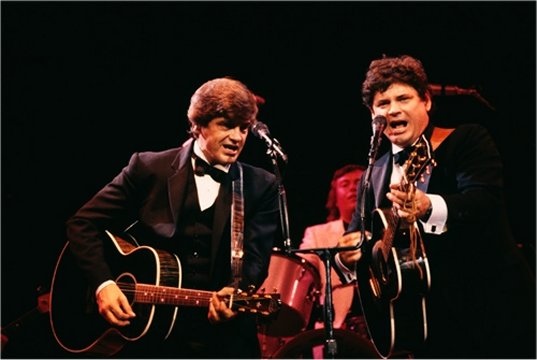 They kicked off their comeback with back-to-back concerts at the Royal Albert Hall in London, where the duo had remained popular through the years. Those two shows were then edited into a television special that played on HBO to critical raves and good ratings.
They kicked off their comeback with back-to-back concerts at the Royal Albert Hall in London, where the duo had remained popular through the years. Those two shows were then edited into a television special that played on HBO to critical raves and good ratings.
Not content to simply be an oldies act playing nothing but memories, the duo also decided to record an album of new material. The result was EB’84, an album that could stand on equal footing with anything they had recorded during their golden age.
The project was produced by Dave Edmunds (who had covered a few of the Everleys songs with frequent collaborator Nick Lowe). Some of the best and brightest in rock lined up to take part. Paul McCartney contributed the album’s first track, “On the Wings of a Nightingale.” From the opening notes, it was clear the boys had not lost a step. Released as single, the song returned the boys to pop charts on both sides of the Atlantic.
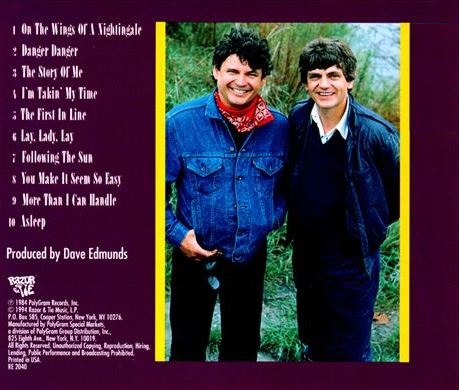 The rest of the album is classic Every Brothers. Here’s the track list with the composers:
The rest of the album is classic Every Brothers. Here’s the track list with the composers:
- “On the Wings of a Nightingale” (Paul McCartney)
- “Danger, Danger” (Frankie Miller)
- “The Story of Me” (Jeff Lynne)
- “I’m Takin’ My Time (Rick Beresford, Patrick Alger)
- “The First in Line” (Phil Kennerly)
- “Lay, Lady, Lay” (Bob Dylan)
- “Following the Sun” (Don Everly)
- “You Make It Seem So Easy” (Don Everly)
- “More Than I Can Handle” (Pete Wingfield - Mike Vernon)
- “Asleep” (Don Everly)
Musician included Dave Edmunds, Albert Lee, Jeff Lynne, Paul McCartney and Richard Tandy.
The best thing about the album is that it has the classic sound of the Everly Brothers but doesn’t feel retro or dated.
If you love Everly classics like “Wake Up Little Susie,” “Bye Bye Love” and the rest, you owe it to yourself to give this album a listen.
Ain't It the Truth: 1950's Edition
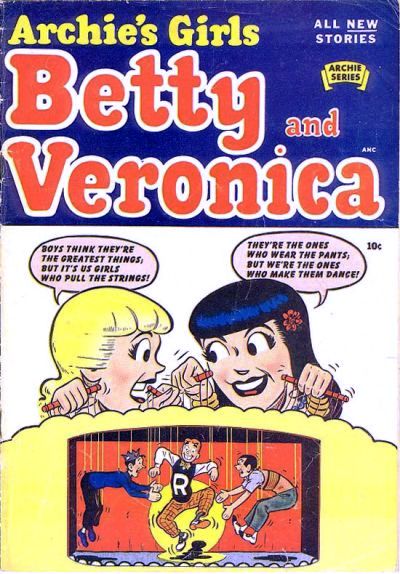
Fit Body = Fit Mind
 Modern research suggest the best way to keep your brain active and sharp is to get exercise for your body!
Modern research suggest the best way to keep your brain active and sharp is to get exercise for your body!
AARP's experts recommend:
- 150 minutes of exercise a week
- Strength training 2 or more times a week
- Lead an active lifestyle
- To stay motivated, consider exercising with a group
Doodyville Babylon?
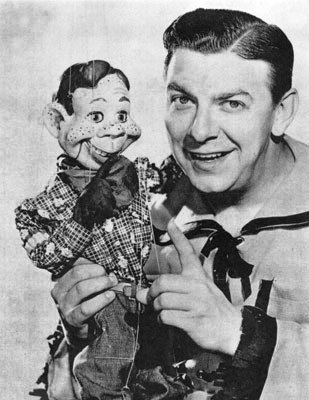 The Life & Times of Howdy Doody – Part 4
The Life & Times of Howdy Doody – Part 4
The puppets on The Howdy Doody Show were fairly easy to control. The flesh and blood actors, not so much. And it was a group of these cast members who almost brought the show to a screeching halt, resulting in the infamous 1953 “Christmas Eve Massacre” as the show was wrapping up its 5th year.
It's time once again to go behind the scenes and discover who was really pulling the strings on It's Howdy Doody Time!
When Baby Boomers reminisce about Howdy Doody, the talk usually focuses on the puppets. But most of the actual air time on the show was actually devoted to Buffalo Bob and a band of real live characters who shared the stage with the puppets, including Clarabell the clown, Chief Thunderthud, and J. Cornelius Cobb who ran the local general store.
Additionally, Dayton Allen, the voice of Mr. Bluster and Flub-a-Dub, also appeared as a variety of live characters whenever the script demanded it. In the early days, Allen portrayed the wrestler Ugly Sam, Pierre the Chef, cowboy Lanky Lou and explorer Sir Archibald, among others.
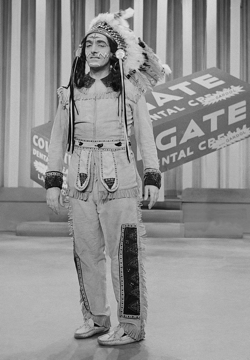 Chief Thunderthud was chief of the Ooragnak tribe (spell it backwards). Actor Bill Lecornec made a lasting contribution to pop culture when he voiced Thunderthud’s trademark greeting, “Cowabunga!” The phrase was soon adopted by California surfers, who in turn influenced the creators of the Teenage Mutant Ninja Turtles. Thanks to the Turtles, the phrase remains current today, although few under the age of 60 realize its true origins. (BTW - Bill was also seen on the show as Oil Well Willie and Doctor Singsong.)
Chief Thunderthud was chief of the Ooragnak tribe (spell it backwards). Actor Bill Lecornec made a lasting contribution to pop culture when he voiced Thunderthud’s trademark greeting, “Cowabunga!” The phrase was soon adopted by California surfers, who in turn influenced the creators of the Teenage Mutant Ninja Turtles. Thanks to the Turtles, the phrase remains current today, although few under the age of 60 realize its true origins. (BTW - Bill was also seen on the show as Oil Well Willie and Doctor Singsong.)
Robert “Nick” Nicholson played the irascible shopkeeper Corny Cobb and other occasional visitors to Doodyville.
But, next to Buffalo Bob, the biggest of the human stars was undoubtedly Clarabell. He never spoke, instead honking one of two horns attached to a box on his waist. One horn was labeled “Yes” and the other “No.” His whole purpose in life seemed to be to squirt seltzer in Buffalo Bob’s face, to the delighted squeals of the Peanut Gallery. (Today, we’d wonder if he had OCD.)
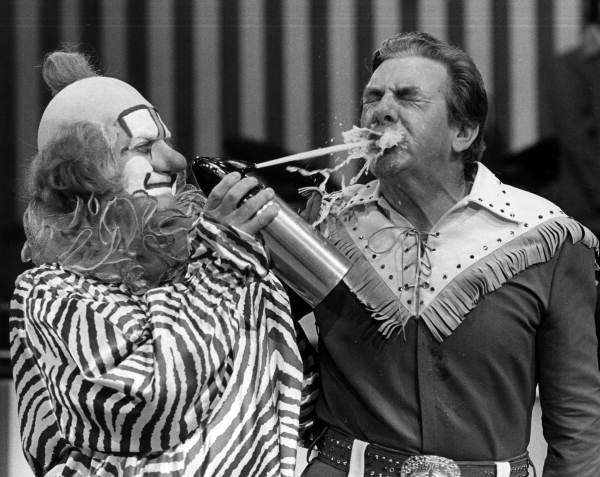 Clarabell was initially portrayed by a young Bob Keeshan. As the show’s popularity skyrocketed, Keeshan received a nice raise, but wanted still more money. NBC disagreed and replaced him with a jazz musician named Lew Anderson, who stayed with the show through the rest of its run. Don’t feel badly for Keeshan. CBS hired him, installed him in the Treasure House and as Captain Kangaroo, his television career lasted far longer than Howdy’s.
Clarabell was initially portrayed by a young Bob Keeshan. As the show’s popularity skyrocketed, Keeshan received a nice raise, but wanted still more money. NBC disagreed and replaced him with a jazz musician named Lew Anderson, who stayed with the show through the rest of its run. Don’t feel badly for Keeshan. CBS hired him, installed him in the Treasure House and as Captain Kangaroo, his television career lasted far longer than Howdy’s.
Joining Keeshan in his demand for higher salary were puppeteer Rhoda Mann (who operated Howdy), Dayton Allen, and Bill Lecornec. They all retained the same agent and made a united “take it or leave it” demand. Bob Smith and the show’s other producers decided to leave it.
But not before calling the show’s entire cast and crew together on December 23, 1953. Bob Smith told everyone exactly what kind of raise the four had asked for, asked them to correct him if he was wrong (they didn’t), and then announced that the show was accepting their resignations immediately. Word spread quickly through the New York broadcasting community about what came to be known as “The Christmas Eve Massacre.”
While the show was able to find replacements for Keeshan, Mann, and Allen, they simply couldn’t find anyone suitable to replace Lecornec. Not only was he unmistakably Chief Thunderthud, he also provided the distinctive voice of Dilly Dally, Howdy’s best bud. So after a few weeks, Buffalo Bob called up Lecornec, mended fences and brought him back to Doodyville (complete with a nice raise). Lecornec stayed with Howdy Doody for the rest of its run, also serving as the show’s general announcer.
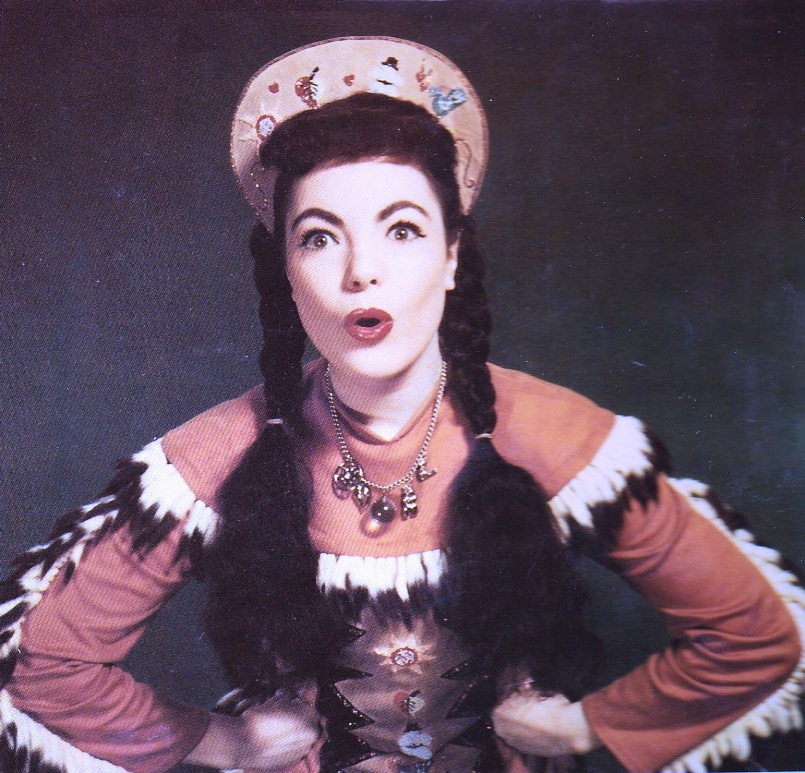 Far and away, the most beloved of the live characters was Princess Summerfall Winterspring, portrayed by the beautiful Judy Tyler. Judy went on to co-star with Elvis Presley in Jailhouse Rock. It looked like she had a great career ahead of her. Sadly, Judy and her husband died in a car accident in 1957 while returning to New York following the completion of the Elvis film.
Far and away, the most beloved of the live characters was Princess Summerfall Winterspring, portrayed by the beautiful Judy Tyler. Judy went on to co-star with Elvis Presley in Jailhouse Rock. It looked like she had a great career ahead of her. Sadly, Judy and her husband died in a car accident in 1957 while returning to New York following the completion of the Elvis film.
The show wasn’t destined to last much longer. As television audiences and production values grew increasingly more sophisticated, Howdy Doody was starting to look a little dated. Having had a good long run (nearly 13 years, much of it 5-days-a-week), Howdy was nearing retirement. The final telecast was on September 24, 1960 and NBC gave the cast and crew an entire hour to say goodbye.
Of course, most of us remember the special surprise they had for us on that last show, when Clarabell admitted that he really could talk! As time ran out, the camera dollied in for a close-up on Clarabell. With a tear streaming down his cheek, he spoke for the first and last time as he said, “Goodbye kids!”
But it wasn’t really the end for Buffalo Bob, Clarabell or Howdy. We’ll have more on that in our next installment.
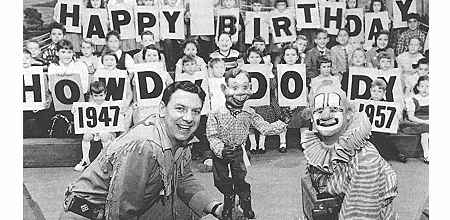
Now Playing at the Boomtown Drive-In!
Wouldn't one think that filth and sweat would enhance primitive cravings? (Asking for a friend.)

Before They Were Stars
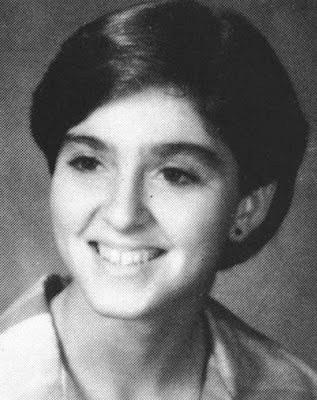
Even the biggest of American pop stars were nerdy teenagers at one time and had to pose for yearbook photos.
And so this is what Madonna looked like in her pre-Material Girl days.
Swearing May Be Good for You, We Swear It's True!
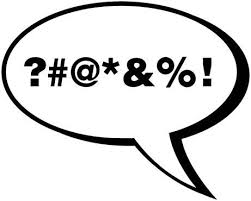 Letting loose with a blast of foul language may have some benefits.
Letting loose with a blast of foul language may have some benefits.
Researchers at Marist College in New York and the Massachusetts College of Liberal Arts determined that people swear profusely also tend to have a wider vocabulary than average.
Another study at England's Keele University found that swearing can help reduce stress and can also help endure physical pain.
Who Remembers Francis the Talking Mule?
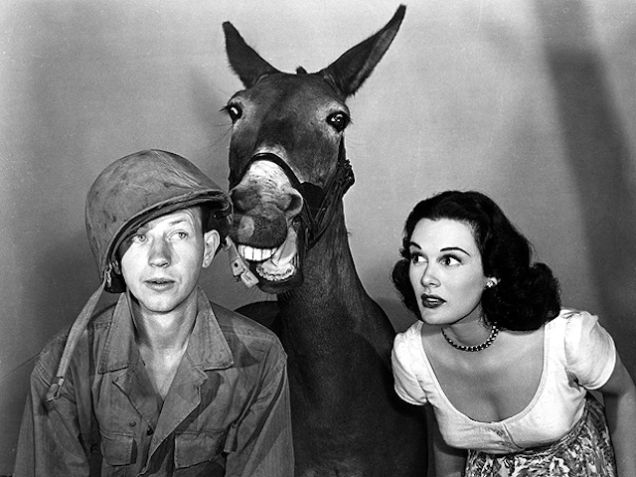 Every Baby Boomer remembers Mister Ed, the talking horse who caused trouble for his owner Wilbur Post. But Ed was actually a rip-off, a cheap TV imitation!
Every Baby Boomer remembers Mister Ed, the talking horse who caused trouble for his owner Wilbur Post. But Ed was actually a rip-off, a cheap TV imitation!
Before Ed ever opened his mouth there was Francis the Talking Mule!
Frances was created by U.S. Army Captain David Stern III. He was in charge of an Army newspaper during WWII. Bored by a lack of news one afternoon, Stern wrote four pages of fanciful dialogue between a U.S. solider and a stubborn Army mule. Intrigued, he expanded the idea into a series of short stories that were subsequently published by Esquire magazine. Stern wrote the stories in the first person and adopted as a pen name, Peter Stirling, the 2nd lieutenant who Francis befriended in the stories.
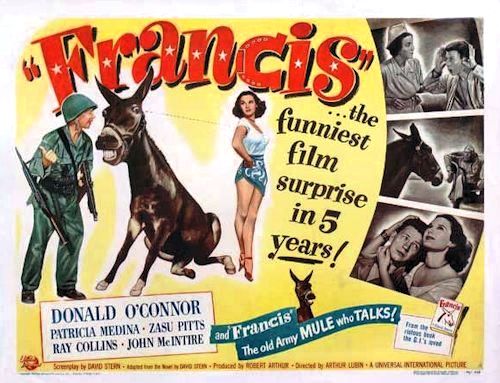 After the war, Stern adapted three of them into a Francis novel. Universal Pictures bought the film rights. In 1950, Francis (no, “the Talking Mule” was not a part of the title) debuted in movie theaters and became a solid money maker for the studio.
After the war, Stern adapted three of them into a Francis novel. Universal Pictures bought the film rights. In 1950, Francis (no, “the Talking Mule” was not a part of the title) debuted in movie theaters and became a solid money maker for the studio.
The first film set the formula for the series. Legendary song and dance man, Donald O’Connor played Peter Stirling. Veteran cowboy actor, Chill Wills (uncredited) provided Francis’ voice. Initially in each picture, Francis would only talk to Stirling. Stirling would take advice from Francis, complications would arise, hilarity would ensure, only to resolve itself when Francis would finally speak in front of others. Closing credits. Fade out. At the start of the next picture, the world would conveniently forget there was ever a talking mule and the cycle would repeat itself.
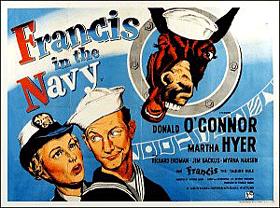 The initial Frances film spawned 6 sequels:
The initial Frances film spawned 6 sequels:
- Francis Goes to the Races (1951)
- Francis Goes to West Point (1952)
- Francis Covers the Big Town (1953)
- Francis Joins the WACS (1954)
- Francis in the Navy (1955)
- Francis in the Haunted House (1956)
Stern actually wrote a sequel to his first Francis novel called Francis Goes to Washington, but for reasons long forgotten, that novel was never adapted into a movie.
O’Connor and Willis left the series after Francis in the Navy with Mickey Rooney and Paul Frees assuming their roles. Most agree that Francis and the Haunted House was the weakest of the series.
Francis was actually played by a female mule named Molly, who got the part because she was easy to train and had a very gentle personality.
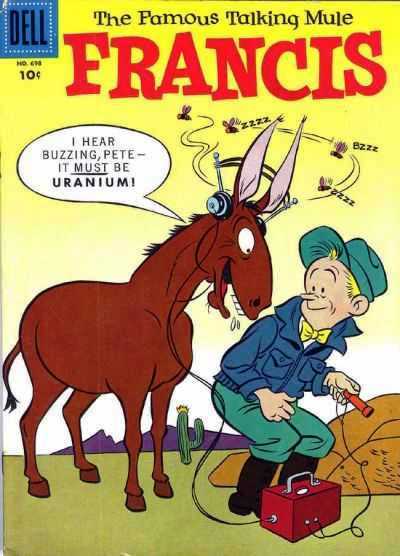 The Francis series was popular enough to spawn a bit of merchandise including a Dell comic book that ran for 17 issues.
The Francis series was popular enough to spawn a bit of merchandise including a Dell comic book that ran for 17 issues.
After the series ran out of gas in movie theaters, the director Arthur Lubin and trainer Les Hilton wanted to bring Francis to TV. When they found they couldn’t secure the rights, they discovered another series of books about a talking animal. Those rights Lubin was able to purchase. The character in those books was a talking horse named “Mister Ed.”
And the rest in television history!
All 7 Francis films are available on home video. While not on the level of, say, Abbott & Costello’s best, they are serviceable little comedies made in a time when talking out of an ass was not such a bad thing!
-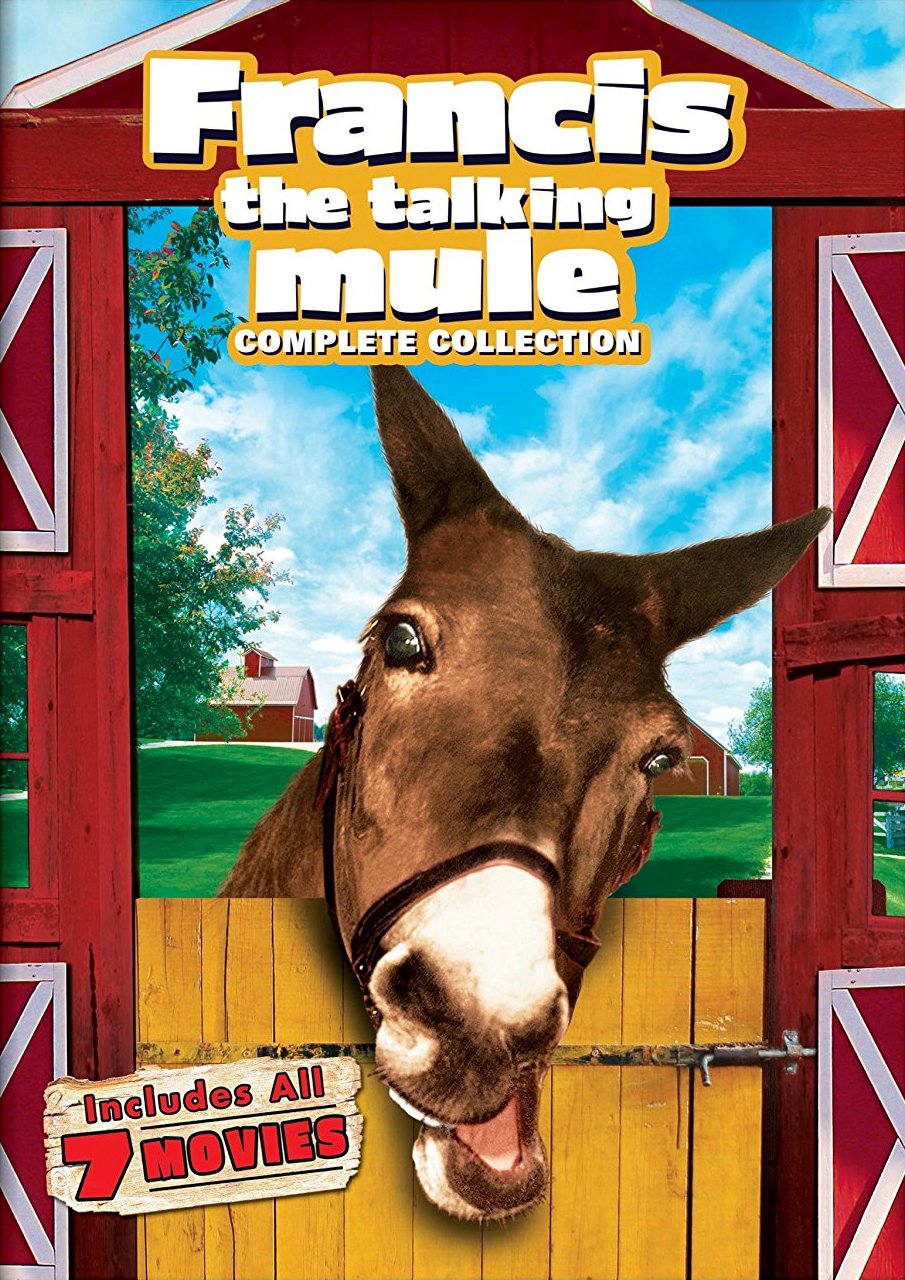
Find Open Parking Space By Phone
 If you live in a big city or are visiting an unfamiliar city, finding a parking space can be a hassle.
If you live in a big city or are visiting an unfamiliar city, finding a parking space can be a hassle.
It doesn’t have to be.
There are a variety of parking apps for your smartphone that can help located and in the case of paid parking, even help you reserve open parking spaces while you’re still on the road!
Here are just a few:
- Parker (TheParkerApp.com)
- SpotHero (SpotHero.com)
- ParkWhiz (ParkWhiz.com)
- BestParking (BestParking.com)
- ParkMe (ParkMe.com)
Thank us later. Right now, you’ve got a parking space to find!
The Top 10 TV Shows for Baby Boomers
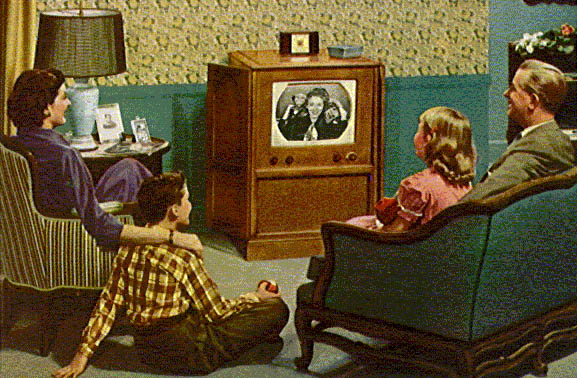 by Allen B. Ury
by Allen B. Ury
There are two kinds of TV series. I'm not talking about "drama" vs. "comedy." Or "prestige" vs. "popular." Or even "good" vs. "crap." I'm talking about "Teflon" vs. "sticky."
Teflon series are those you watch -- and may even enjoy -- but their impact slides away like eggs off a greased skillet. Some Teflon series are highly rated. Some Teflon series even win prestigious awards. But in the end, Teflon series tend to fade into obscurity like some exotic avian species, what minor fossils they leave behind to be carefully picked over, studied and debated by small cadres of dedicated media historians, but otherwise forgotten by later generations.
And then there are "sticky" series. Sticky -- in the modern marketing vernacular -- refers to ideas or concepts that not only tap into the current cultural zeitgeist, but have true staying power. Many "sticky" TV series are low-rated. Some last only a few seasons. They may even be critical pariahs. But, even in cancellation, they refuse to go away. They become part of us. Part of our cultural DNA. And thus part of our shared memories. (As well as topics for endless Internet click-bait articles.)
The Baby Boomer era for popular culture -- roughly 1950-1975 -- was rife with both Teflon and sticky TV series. This was the era that critics called both "TV's Golden Age" and "a vast wasteland." It produced series that, at the time, won critical plaudits but which today are all but forgotten. (This is particularly true of 1950s era dramatic anthology series like Playhouse 90 and Studio One, prestige programs that were broadcast live and thus never syndicated.) It also produced shows that were critically reviled yet are still held warmly in the hearts of aging Boomers (e.g. My Favorite Martian, The Beverly Hillbillies, The Brady Bunch, Hogan's Heroes, etc.)
Here’s my list of the Top 10 TV Shows for Baby Boomers. Presented in chronological order, the list represents what I believe are the "stickiest" shows from this 25-year period. Like all lists, it's woefully incomplete and probably not reflective of everyone's tastes. But I suspect you'll find several of your favorites in this collection. And some wonderful memories as well.
- The Ed Sullivan Show (1948-1971)
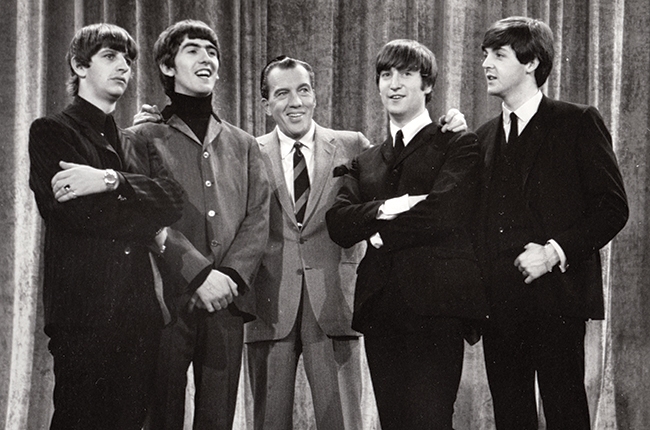 The Ed Sullivan Show -- originally Ed Sullivan's Toast of the Town -- not only helped define the Baby Boom generation, it served as a cultural bridge between Boomers and their parents. Here was a show that the entire family literally watched together. Kids, bored with the opera singers, Broadway show tune belters and Borcht Belt comics, could enjoy the latest rock-and-roll sensations from Elvis to the Beatles to the Rolling Stones, cutting-edge comics like George Carlin, Flip Wilson and Richard Pryor, and those weird specialty acts like Senor Wences and Topo Gigio. Sullivan's unique blend of Vaudeville, Carnegie Hall and American Bandstand defined and legitimized much of what became Baby Boomer culture, telling our often resistant parents that Janis Joplin, BB King and the Mamas & The Papas were as worthy as Frank Sinatra, Judy Garland and Perry Como
The Ed Sullivan Show -- originally Ed Sullivan's Toast of the Town -- not only helped define the Baby Boom generation, it served as a cultural bridge between Boomers and their parents. Here was a show that the entire family literally watched together. Kids, bored with the opera singers, Broadway show tune belters and Borcht Belt comics, could enjoy the latest rock-and-roll sensations from Elvis to the Beatles to the Rolling Stones, cutting-edge comics like George Carlin, Flip Wilson and Richard Pryor, and those weird specialty acts like Senor Wences and Topo Gigio. Sullivan's unique blend of Vaudeville, Carnegie Hall and American Bandstand defined and legitimized much of what became Baby Boomer culture, telling our often resistant parents that Janis Joplin, BB King and the Mamas & The Papas were as worthy as Frank Sinatra, Judy Garland and Perry Como
- I Love Lucy (1951-1957)
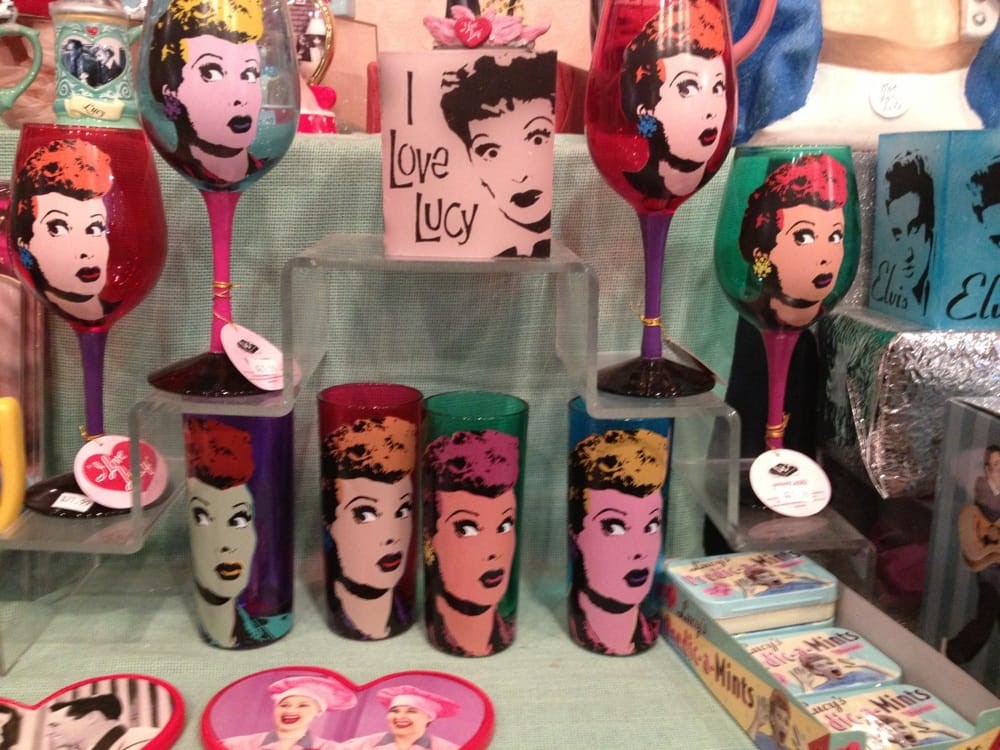 Broadcast TV's first comedy megahit is also one of its moved beloved -- and influential. Technically, the show created a template that TV sit-com producers continues to use to this day. I speak of the three-camera process -- invented by the show's co-star Desi Arnaz -- and shooting in front of a live studio audience. That he and Lucy also decided to shoot their show on film rather than broadcast it live made it the first and ultimately one of most successful syndicated TV series of all time. But that's all behind-the-scenes stuff. What made Lucy "sticky" was its unique and brilliant blend of timeless 1930s-era slapstick and prescient 1960s-era proto-feminism. The premise of virtually every episode was Lucy's desire to break out of the 1950s housewife mold and join her husband's nightclub act. She not only wanted to work -- but work as her husband's equal. That her ambitions were inevitably thwarted by her own incompetence didn't make the underlying message any less valid…or subversive. Couple that with the fact Lucille Ball was a powerhouse producer who can ran her production company, Desliu Studios, like a classic Hollywood mogul, and it's easy see why Lucy the character and Lucy the woman have become iconic emblems of the Baby Boom era.
Broadcast TV's first comedy megahit is also one of its moved beloved -- and influential. Technically, the show created a template that TV sit-com producers continues to use to this day. I speak of the three-camera process -- invented by the show's co-star Desi Arnaz -- and shooting in front of a live studio audience. That he and Lucy also decided to shoot their show on film rather than broadcast it live made it the first and ultimately one of most successful syndicated TV series of all time. But that's all behind-the-scenes stuff. What made Lucy "sticky" was its unique and brilliant blend of timeless 1930s-era slapstick and prescient 1960s-era proto-feminism. The premise of virtually every episode was Lucy's desire to break out of the 1950s housewife mold and join her husband's nightclub act. She not only wanted to work -- but work as her husband's equal. That her ambitions were inevitably thwarted by her own incompetence didn't make the underlying message any less valid…or subversive. Couple that with the fact Lucille Ball was a powerhouse producer who can ran her production company, Desliu Studios, like a classic Hollywood mogul, and it's easy see why Lucy the character and Lucy the woman have become iconic emblems of the Baby Boom era.
- The Mickey Mouse Club (1955-1959)
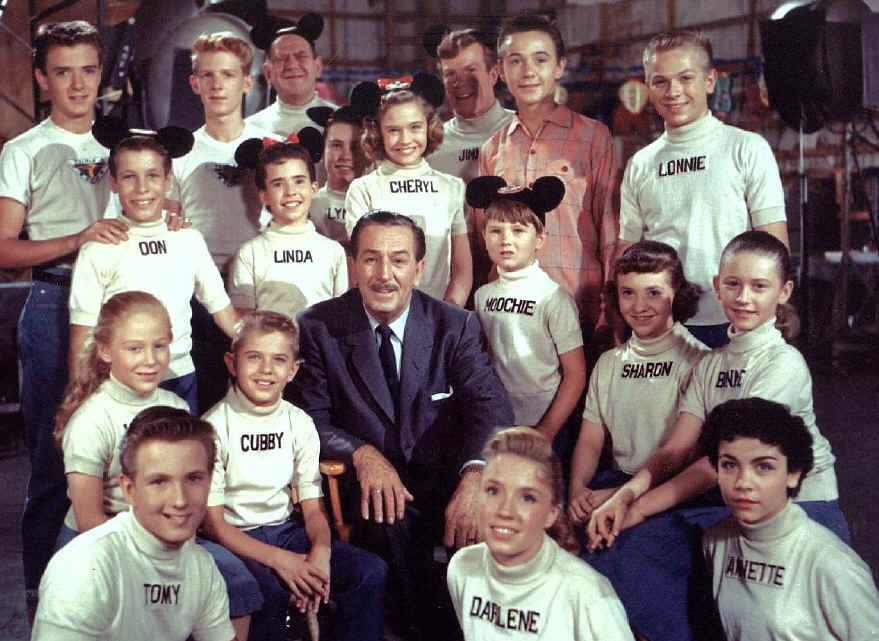 It was the Walt Disney Co. that perfected the science of blending popular art with merchandising. Every Disney movie promoted a Disney product that promoted a Disney theme park that promoted more movies, etc., etc., etc. Like a tobacco company, Disney knew that the best way to hook customers into this purchasing cycle was to get them while they were young. And hence the Mickey Mouse Club was born. Although produced on a shoestring budget, the show was expertly cast to appeal to everyone from preschoolers to pre-teens, and was supported by the peerless craftsmen of Disney's live action, animation and music departments who peppered the show with short but slick adventure serials (e.g. "The Adventures of Spin and Marty") and animated featurettes featuring popular Disney characters, most notably Pinocchio's Jiminy Cricket. Like Sesame Street would do for Generation X'ers 15 years later, The Mickey Mouse Club taught Boomers about manners, safety, sharing and science. Its breakout star, Annette Funicello, also taught young Boomer males about the wonders of female body development. Who's the leader of the Club that's made for you and me? Sing it. You know you want to.
It was the Walt Disney Co. that perfected the science of blending popular art with merchandising. Every Disney movie promoted a Disney product that promoted a Disney theme park that promoted more movies, etc., etc., etc. Like a tobacco company, Disney knew that the best way to hook customers into this purchasing cycle was to get them while they were young. And hence the Mickey Mouse Club was born. Although produced on a shoestring budget, the show was expertly cast to appeal to everyone from preschoolers to pre-teens, and was supported by the peerless craftsmen of Disney's live action, animation and music departments who peppered the show with short but slick adventure serials (e.g. "The Adventures of Spin and Marty") and animated featurettes featuring popular Disney characters, most notably Pinocchio's Jiminy Cricket. Like Sesame Street would do for Generation X'ers 15 years later, The Mickey Mouse Club taught Boomers about manners, safety, sharing and science. Its breakout star, Annette Funicello, also taught young Boomer males about the wonders of female body development. Who's the leader of the Club that's made for you and me? Sing it. You know you want to.
- Leave It to Beaver (1957-1963)
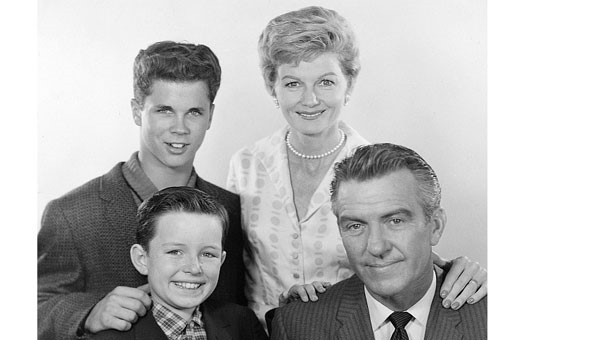 Speak of Eisenhower-Era suburban "normalcy," and two TV sit-coms are inevitably referenced: "Father Knows Best" and "Leave It to Beaver." Both shows represented suburban America as an idyllic, affluent, happy, safe and, yes, white Utopia where problems all tended to be rooted in misunderstandings and no crisis was too big that it couldn't be resolved by wise parenting within 24 minutes. Two key factors tend to make "Beaver" the most memorable and "sticky" of the two shows. One, its stories were told from the kids' point of view, not the parents, which made them more relatable to young Boomers. But its real distinguishing feature was the brilliantly conceived character of Wally Cleaver's best friend, Eddie Haskell. Eddie was a scheming, two-faced, smarmy, glad-handing, manipulative quasi-sociopath destined to wind up either in jail or on Wall Street. Maybe both. (Ironically, the actor who played him, Adam Zolotin (billed as "Ken Osmond"), ended up working as a cop for the LAPD.) While mother June Cleaver gave the show its heart and father Ward Cleaver gave the show its gravitas, it was snarky, sleazy Eddie who gave the show its edge. Down deep, we all wanted to be Eddie Haskell.
Speak of Eisenhower-Era suburban "normalcy," and two TV sit-coms are inevitably referenced: "Father Knows Best" and "Leave It to Beaver." Both shows represented suburban America as an idyllic, affluent, happy, safe and, yes, white Utopia where problems all tended to be rooted in misunderstandings and no crisis was too big that it couldn't be resolved by wise parenting within 24 minutes. Two key factors tend to make "Beaver" the most memorable and "sticky" of the two shows. One, its stories were told from the kids' point of view, not the parents, which made them more relatable to young Boomers. But its real distinguishing feature was the brilliantly conceived character of Wally Cleaver's best friend, Eddie Haskell. Eddie was a scheming, two-faced, smarmy, glad-handing, manipulative quasi-sociopath destined to wind up either in jail or on Wall Street. Maybe both. (Ironically, the actor who played him, Adam Zolotin (billed as "Ken Osmond"), ended up working as a cop for the LAPD.) While mother June Cleaver gave the show its heart and father Ward Cleaver gave the show its gravitas, it was snarky, sleazy Eddie who gave the show its edge. Down deep, we all wanted to be Eddie Haskell.
- The Twilight Zone (1959-1964)
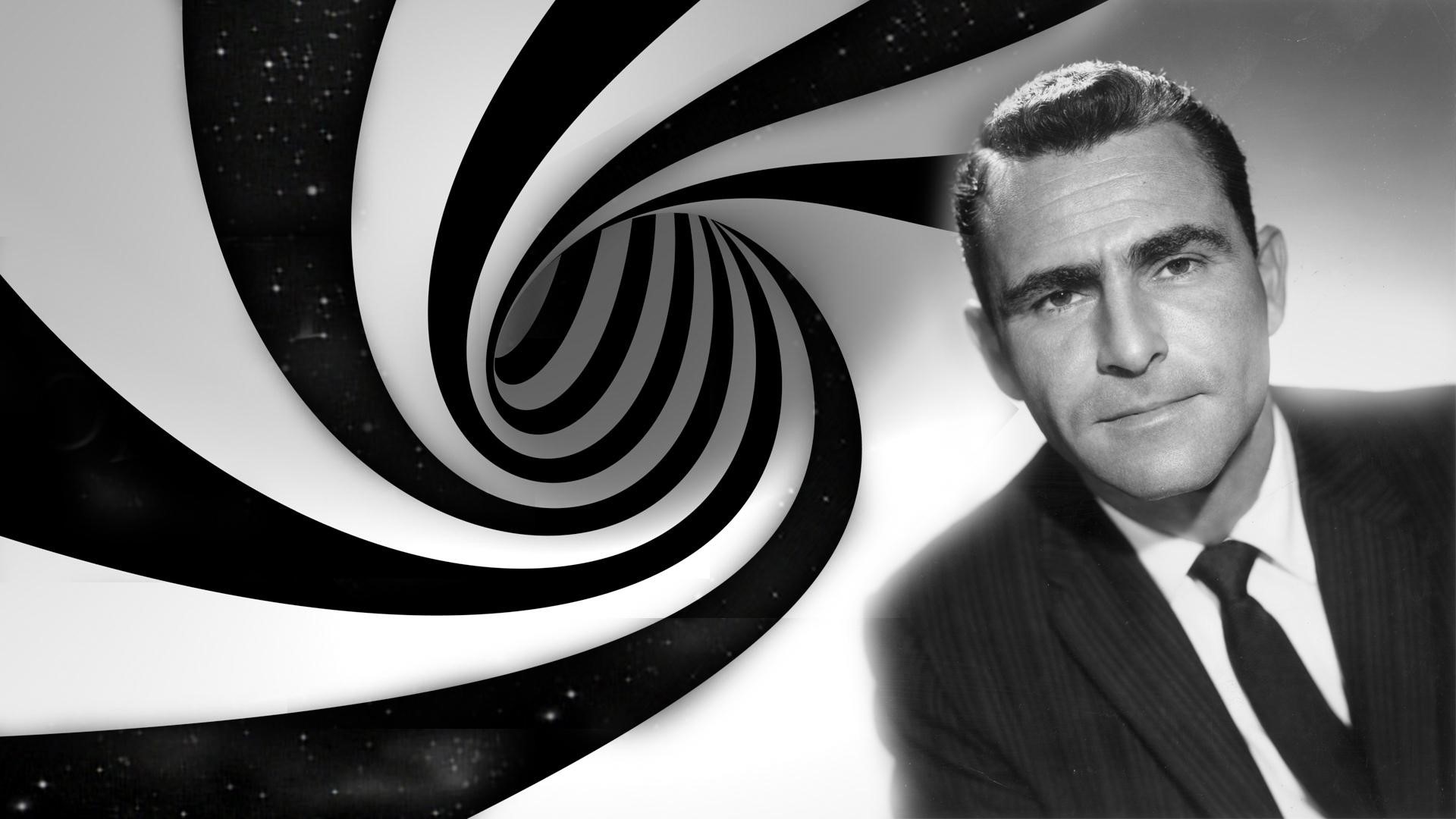 If "The Mickey Mouse Club" was our kindergarten and "Leave It to Beaver" our grammar school, then "The Twilight Zone" was our high school, complete with all the angst, hope, bitterness, sentimentality and sheer terror that life phase embodies. It was from Rod Serling's master class in human nature that we learned life lessons in bigotry, nobility, karma, spirituality and, most of all, irony. We entered "The Twilight Zone" as children, but departed as adults, sadder but wiser in the ways of our often capricious universe, now aware that nightmares sprang not from some unseen realm of angels and demons but from the darkness of our own souls.
If "The Mickey Mouse Club" was our kindergarten and "Leave It to Beaver" our grammar school, then "The Twilight Zone" was our high school, complete with all the angst, hope, bitterness, sentimentality and sheer terror that life phase embodies. It was from Rod Serling's master class in human nature that we learned life lessons in bigotry, nobility, karma, spirituality and, most of all, irony. We entered "The Twilight Zone" as children, but departed as adults, sadder but wiser in the ways of our often capricious universe, now aware that nightmares sprang not from some unseen realm of angels and demons but from the darkness of our own souls.
- The Dick Van Dyke Show (1961-1966)
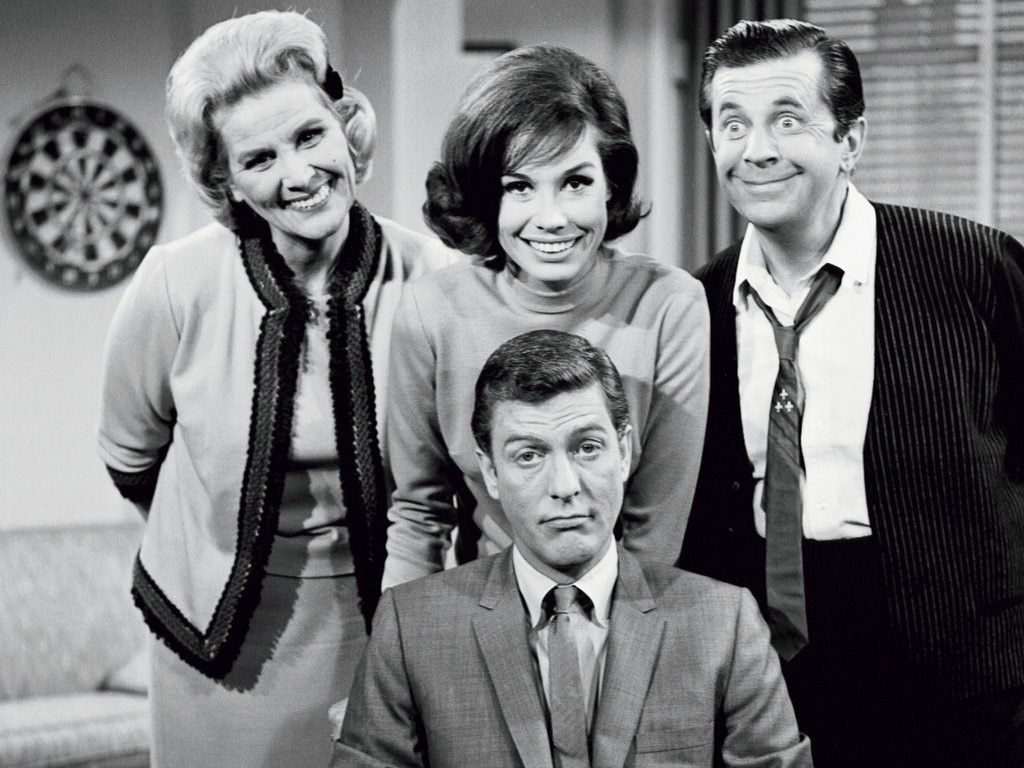 For young Boomers, the Dick Van Dyke Show promised a world of adulthood that made the prospect of growing up actually attractive. Not only was this one of the first sit-coms to take us out of the suburban home and into the workplace (In the worlds of Leave it to Beaver, Father Knows Best, The Adventures of Ozzie & Harriet, etc., we barely had a hint that the fathers were gainfully employed), but it made that workplace look like fun! Instead of toiling in a sweaty factory or at some dreary desk job, the writers of the fictional "Alan Brady Show" -- both male and female -- got to spend all day swapping jokes, hurling insults and perfecting pratfalls. Not only did this make working look like a blast, but if you were a guy, getting to go home to Capri pants-wearing Mary Tyler Moore made the whole adult thing a concept we could get into. Enthusiastically. For those of us lucky enough to subsequently have a career in any form of mass media, there's little doubt our mental templates were formed by The Dick Van Dyke Show.
For young Boomers, the Dick Van Dyke Show promised a world of adulthood that made the prospect of growing up actually attractive. Not only was this one of the first sit-coms to take us out of the suburban home and into the workplace (In the worlds of Leave it to Beaver, Father Knows Best, The Adventures of Ozzie & Harriet, etc., we barely had a hint that the fathers were gainfully employed), but it made that workplace look like fun! Instead of toiling in a sweaty factory or at some dreary desk job, the writers of the fictional "Alan Brady Show" -- both male and female -- got to spend all day swapping jokes, hurling insults and perfecting pratfalls. Not only did this make working look like a blast, but if you were a guy, getting to go home to Capri pants-wearing Mary Tyler Moore made the whole adult thing a concept we could get into. Enthusiastically. For those of us lucky enough to subsequently have a career in any form of mass media, there's little doubt our mental templates were formed by The Dick Van Dyke Show.
- Gilligan's Island (1964-1967)
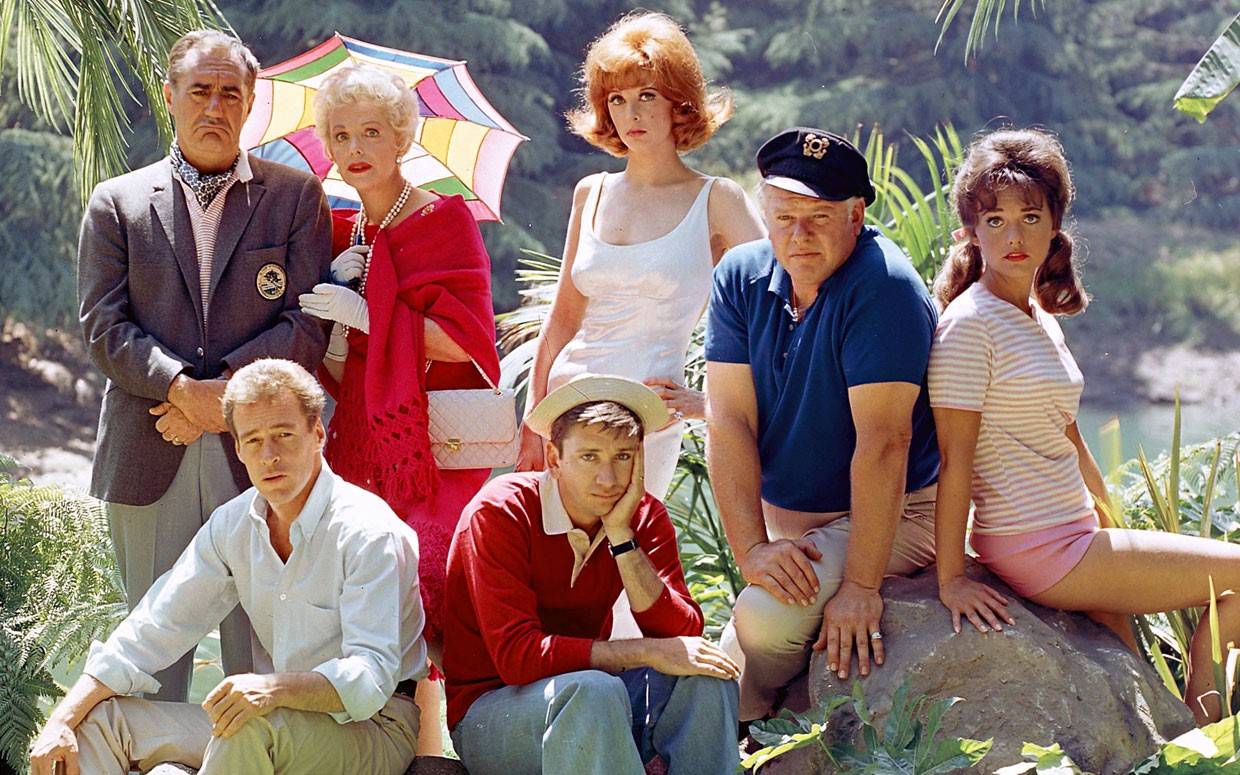 When FCC Chairman Newton Minow famously described network TV as "a vast wasteland" in 1961, this was exactly the kind of show he was talking about. It was mindless. It was juvenile. It had all the emotional and intellectual depth of an oil slick. Not that the show's creator, Sherwood Schwartz, had lofty ambitions. In fact, he famously named his castaways' doomed ship "The Minnow" in honor of the critical FCC chairman. If the show was so bad, why do we still talk about it today? Why is its theme song (also written by Schwartz) part of the Great American Songbook? It's not the writing. It's not the acting. No, it's the concept. Take a bunch of unrelated people representing a wide range of economic and social strata, isolate them, force them to work together, then sit back and enjoy the fun. Without Gilligan's Island, we would never have had Big Brother. Or Survivor. Or Lost. Or The Walking Dead. (More than 50 years later, we're still pondering the age-old question: Ginger or Mary Anne?)
When FCC Chairman Newton Minow famously described network TV as "a vast wasteland" in 1961, this was exactly the kind of show he was talking about. It was mindless. It was juvenile. It had all the emotional and intellectual depth of an oil slick. Not that the show's creator, Sherwood Schwartz, had lofty ambitions. In fact, he famously named his castaways' doomed ship "The Minnow" in honor of the critical FCC chairman. If the show was so bad, why do we still talk about it today? Why is its theme song (also written by Schwartz) part of the Great American Songbook? It's not the writing. It's not the acting. No, it's the concept. Take a bunch of unrelated people representing a wide range of economic and social strata, isolate them, force them to work together, then sit back and enjoy the fun. Without Gilligan's Island, we would never have had Big Brother. Or Survivor. Or Lost. Or The Walking Dead. (More than 50 years later, we're still pondering the age-old question: Ginger or Mary Anne?)
- Star Trek (1966-1969)
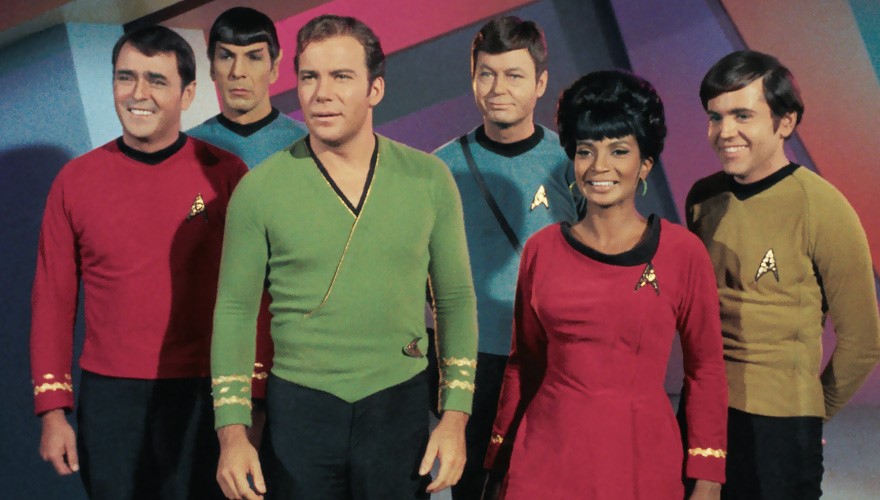 "Space…the Final Frontier…." These opening lines continue to give us anticipatory chills, even to this day. Premiering just as the U.S. Space Program was finally hitting its stride -- and as urban race riots and Vietnam casualty reports were starting to undermine America's faith in its government and institutions -- "Star Trek" told us that the future was something we could look forward to. Marketed as "TV's first adult science fiction series" -- to separate it from the its Captain Video, Tom Corbett and Lost in Space antecedents -- "Star Trek" tapped the talent of some of America's top science fiction writers, including Theodore Sturgeon, Norman Spinrad, Robert Bloch and Harlan Ellison, to take our collective imaginations to the far edges of the galaxy at warp speed. The U.S.S. Enterprise is arguably the most famous fictional spacecraft of all time, the show's core characters -- Captain Kirk, Mr. Spock, Dr. McCoy, Montgomery Scott -- now as iconic as Sherlock Holmes, Atticus Finch and James Bond. Although lacking today's technical sophistication, hobbled by some cheesy over-acting, garish sets and Mad Men-era sexism, "Star Trek" has endured like few other Baby Boom-era properties, launching more than a half-dozen spin-off series and more than a dozen big-budget motion pictures. We can also thank it for inspiring the flip phone.
"Space…the Final Frontier…." These opening lines continue to give us anticipatory chills, even to this day. Premiering just as the U.S. Space Program was finally hitting its stride -- and as urban race riots and Vietnam casualty reports were starting to undermine America's faith in its government and institutions -- "Star Trek" told us that the future was something we could look forward to. Marketed as "TV's first adult science fiction series" -- to separate it from the its Captain Video, Tom Corbett and Lost in Space antecedents -- "Star Trek" tapped the talent of some of America's top science fiction writers, including Theodore Sturgeon, Norman Spinrad, Robert Bloch and Harlan Ellison, to take our collective imaginations to the far edges of the galaxy at warp speed. The U.S.S. Enterprise is arguably the most famous fictional spacecraft of all time, the show's core characters -- Captain Kirk, Mr. Spock, Dr. McCoy, Montgomery Scott -- now as iconic as Sherlock Holmes, Atticus Finch and James Bond. Although lacking today's technical sophistication, hobbled by some cheesy over-acting, garish sets and Mad Men-era sexism, "Star Trek" has endured like few other Baby Boom-era properties, launching more than a half-dozen spin-off series and more than a dozen big-budget motion pictures. We can also thank it for inspiring the flip phone.
- M*A*S*H (1972-1983)
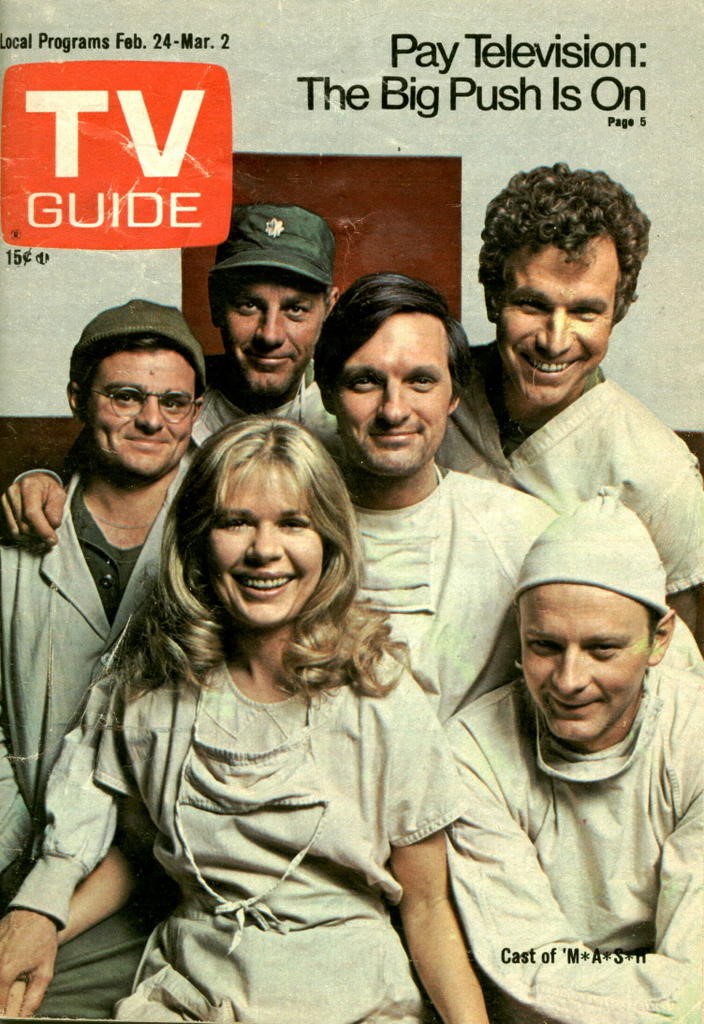 Based on Robert Altman's 1970 counter-culture hit -- itself based on Richard Hooker's less-than-counter-culture 1968 novel -- M*A*S*H blended late 1960s anti-war sentiment, Mad Magazine-era cynicism and Marx Brothers-inspired anarchy to create one of the great comedy/dramas of all time. Although ostensibly set during the Korean War (1950-1953), M*A*S*H was clearly an allegory for the insanity of the Vietnam conflict that was still raging when the show premiered, and boisterously affirmed every suspicion the Boomer generation had about authority, bureaucracy, conformity and the military-industrial complex. The irony of M*A*S*H was that it not only lasted three times longer than the Korean War itself, but was still going strong even after the Vietnam War had vanished in America's cultural rear-view mirror. One of the most successful syndicated series of all time -- the holder of the most-viewed series finale in history -- M*A*S*H embodied the Boomer generation's last burst of lofty idealism before the Reagan Era would send it crashing back to Earth.
Based on Robert Altman's 1970 counter-culture hit -- itself based on Richard Hooker's less-than-counter-culture 1968 novel -- M*A*S*H blended late 1960s anti-war sentiment, Mad Magazine-era cynicism and Marx Brothers-inspired anarchy to create one of the great comedy/dramas of all time. Although ostensibly set during the Korean War (1950-1953), M*A*S*H was clearly an allegory for the insanity of the Vietnam conflict that was still raging when the show premiered, and boisterously affirmed every suspicion the Boomer generation had about authority, bureaucracy, conformity and the military-industrial complex. The irony of M*A*S*H was that it not only lasted three times longer than the Korean War itself, but was still going strong even after the Vietnam War had vanished in America's cultural rear-view mirror. One of the most successful syndicated series of all time -- the holder of the most-viewed series finale in history -- M*A*S*H embodied the Boomer generation's last burst of lofty idealism before the Reagan Era would send it crashing back to Earth.
- SATURDAY NIGHT LIVE (1975-PRESENT)
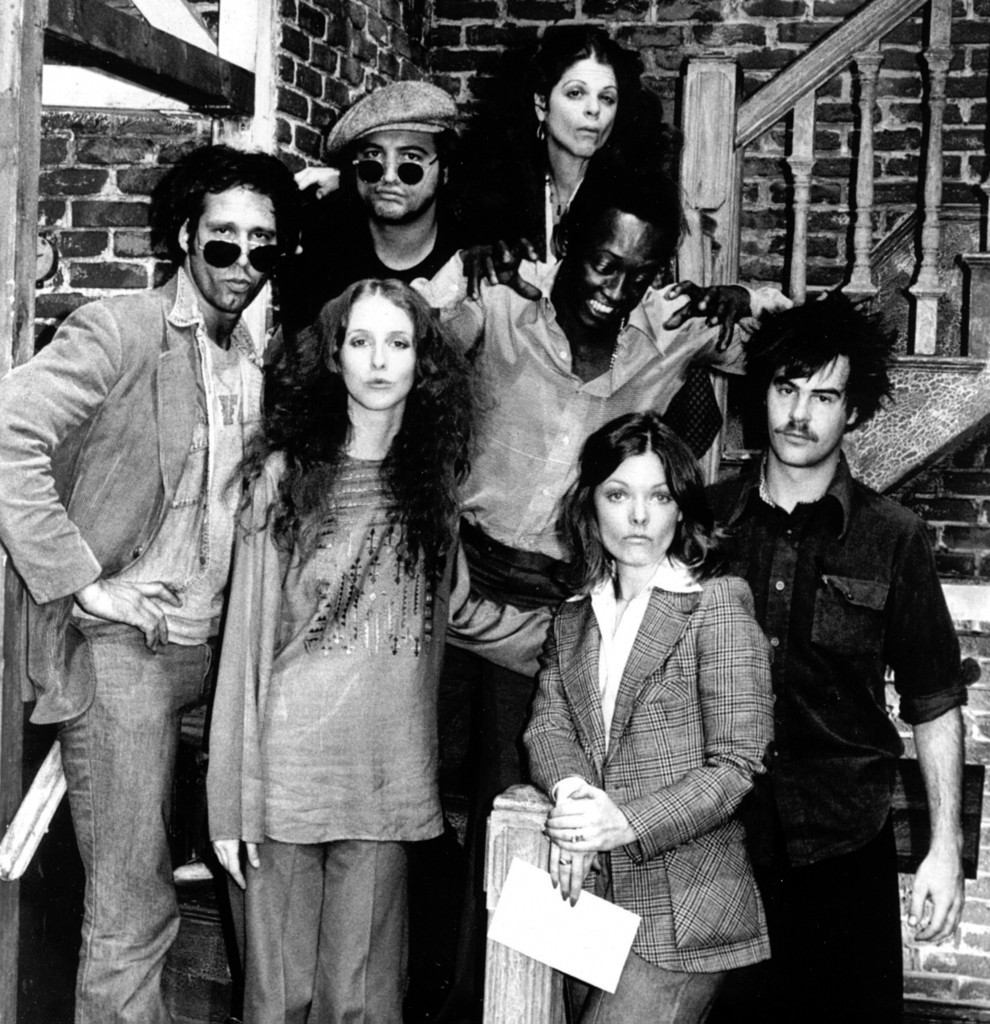 SNL (or simply "Saturday Night" as it was original called), was the transitional TV series for the Baby Boom generation in that it was the first show FOR Boomers written BY Boomers. The show's key creative staff -- producer Lorne Michaels, writers Michael O'Donoghue, Anne Beats, Al Franklin, Chevy Chase -- were all Harvard Lampoon and Second City alum who'd come of age during the turbulent 60s and were now ready to show the WWII Generation how it's done. Reflecting the satirical, urbane and topical sensibilities of Mad Magazine, Jay Ward's Rocky & Bullwinkle cartoons, That Was the Week That Was and character-centric improv comedy, SNL quickly became the hottest thing on TV, creating the staging ground for what would be three generations of top TV and motion picture comedy talent. (Not to mention one U.S. Senator.) That SNL continues to be relevant in the 21st century demonstrates that, despite its many internal contradictions, fragile idealism and, some would say, bloated sense of self-importance, the Baby Boom generation's rebellious streak proved to be a valuable and enduring contribution to the American experiment.
SNL (or simply "Saturday Night" as it was original called), was the transitional TV series for the Baby Boom generation in that it was the first show FOR Boomers written BY Boomers. The show's key creative staff -- producer Lorne Michaels, writers Michael O'Donoghue, Anne Beats, Al Franklin, Chevy Chase -- were all Harvard Lampoon and Second City alum who'd come of age during the turbulent 60s and were now ready to show the WWII Generation how it's done. Reflecting the satirical, urbane and topical sensibilities of Mad Magazine, Jay Ward's Rocky & Bullwinkle cartoons, That Was the Week That Was and character-centric improv comedy, SNL quickly became the hottest thing on TV, creating the staging ground for what would be three generations of top TV and motion picture comedy talent. (Not to mention one U.S. Senator.) That SNL continues to be relevant in the 21st century demonstrates that, despite its many internal contradictions, fragile idealism and, some would say, bloated sense of self-importance, the Baby Boom generation's rebellious streak proved to be a valuable and enduring contribution to the American experiment.
About the Author: Allen Ury is a quintessential Boomer (born in 1954) who was weaned on television. A sometimes TV- and screenwriter with more than 20 published children's horror books to his credit as well as his own line of science fiction model kits, Allen currently lives and works in beautiful Orange County, Calif., where he still watches way too much TV.
Pop Up Player
Latest Posts–Movies & TV
-
The TV That Time Forgot: Annie Oakley
There was a time when Westerns dominated television programming so thoroughly that it was tough (with no home video, no streaming, and just 3 networks if you lived in a city big enough to have…
-
The TV That Time Forgot: My Living Doll (1964-65)
For a show that lasted only a single season, a surprising number of Baby Boomers remember the situation comedy My Living Doll. Perhaps that’s because once seen, Julie Newmar cannot easily be forgotten. The situation…
-
Alfred Hitchcock Presents
While often lumped together with “The Twilight Zone” and “Boris Karloff’s Thriller,” “Alfred Hitchcock Presents” is the true original, debuting 4 years before TZ and 5 before “Thriller.” Alfred Hitchcock’s show was also different than…
-
The TV That Time Forgot: The Donna Reed Show
For 8 seasons, The Donna Reed Show provided Baby Boomers with a sort of Mother Knows Best amid a ton of family sitcoms focused on the father. Cast as Donna Stone, Donna presided over a…
-
Friday Night at the Drive-In: Lover Come Back (1961)
Sequels & remakes? Nothing new here – Hollywood’s been recycling stuff ever since the first “magic lantern shows.” Want proof? Let’s settle in to watch one of those terribly puritanical “sex comedies” from the Sixties…
-
The TV That Time Forgot: The Millionaire
Boy! Could we use a show like this in real life! From 1955 to 1960, for 5 seasons an eccentric millionaire would give away $1 million to somebody he never even met. We were allowed…


